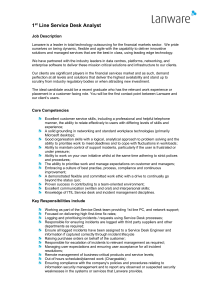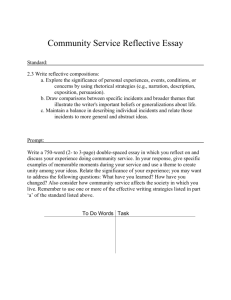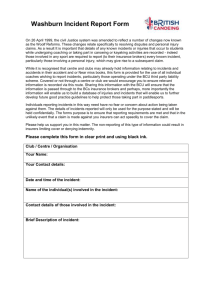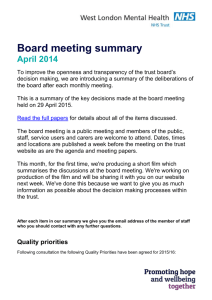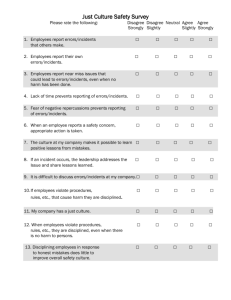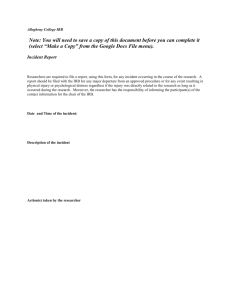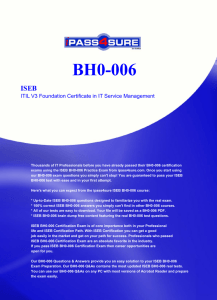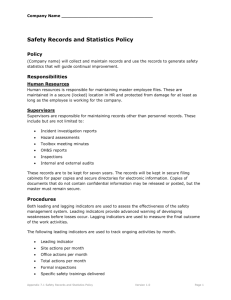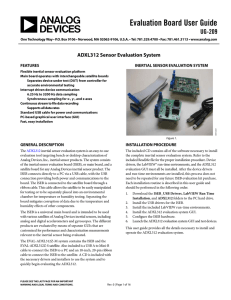question 1 - ITIL tests
advertisement
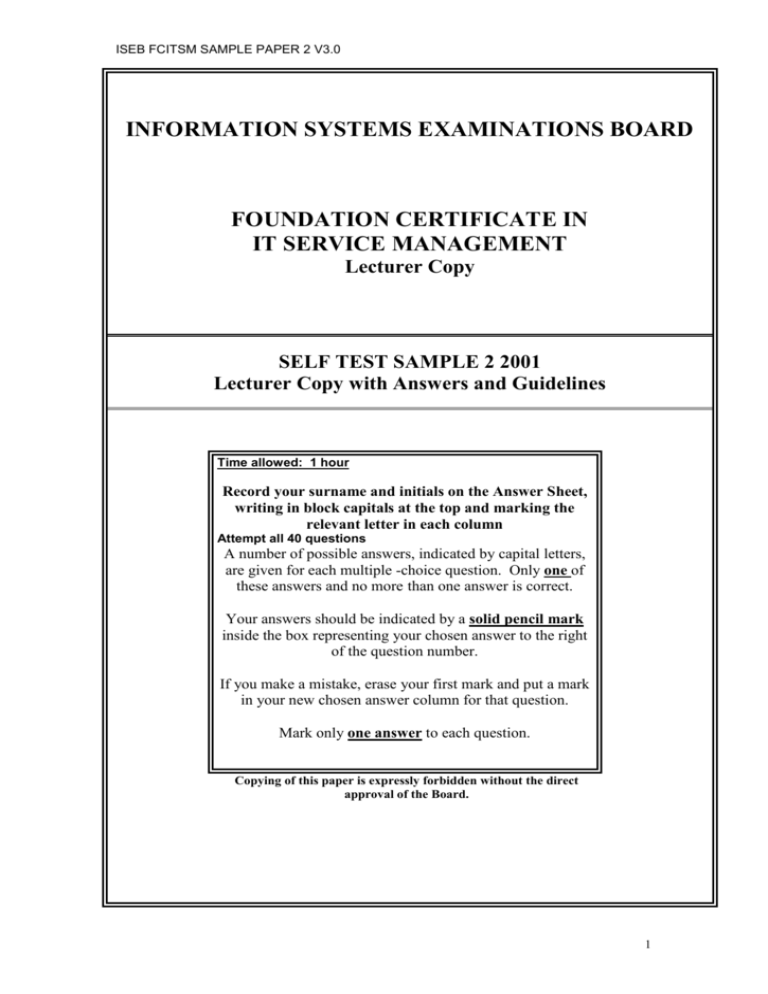
ISEB FCITSM SAMPLE PAPER 2 V3.0 INFORMATION SYSTEMS EXAMINATIONS BOARD FOUNDATION CERTIFICATE IN IT SERVICE MANAGEMENT Lecturer Copy SELF TEST SAMPLE 2 2001 Lecturer Copy with Answers and Guidelines Time allowed: 1 hour Record your surname and initials on the Answer Sheet, writing in block capitals at the top and marking the relevant letter in each column Attempt all 40 questions A number of possible answers, indicated by capital letters, are given for each multiple -choice question. Only one of these answers and no more than one answer is correct. Your answers should be indicated by a solid pencil mark inside the box representing your chosen answer to the right of the question number. If you make a mistake, erase your first mark and put a mark in your new chosen answer column for that question. Mark only one answer to each question. Copying of this paper is expressly forbidden without the direct approval of the Board. 1 ISEB FCITSM SAMPLE PAPER 2 V3.0 QUESTION 1 Which of the following lists best describes the key attributes needed by Service Desk Staff? A B C D Good interpersonal skills; tenacious; technically astute; firm Business aware; articulate; methodical; tolerant; good interpersonal skills Logical; methodical; tenacious; forthright; analytical Well presented; technical specialist; numerate; good interpersonal skills QUESTION 2 Which of the ITIL processes is responsible for ensuring the organisation is aware of new and changing technology? A B C D Capacity Management Change Management Financial Management for IT Services Configuration Management QUESTION 3 Which incidents should be logged by the Service Desk? A B C D Only incidents not resolved at logging Only incidents from bona fide customers All incidents except simple enquiries All incidents QUESTION 4 What information does Configuration Management provide to the IT management of an organisation? A B C D Variations from the agreed service levels Time spent on investigation and diagnosis by each support group Number of incidents and problems per category Details and history of the IT infrastructure QUESTION 5 The words Delta, Full and Package describe different types of release. Which one of the following statements is true? A B C D A Package release contains hardware and software Urgent changes are always Delta releases A Delta release is only ever part of a Package release A Full release releases the ‘normal release unit’ into the live environment 2 ISEB FCITSM SAMPLE PAPER 2 V3.0 QUESTION 6 Availability Management is responsible for ……….. 1 2 3 understanding the reliability of components to carry out a required function under given conditions over a certain period of time the ease with which maintenance of service components can be carried out negotiating availability levels with customers Which of these is correct? A B C D Only 2 & 3 Only 1 & 2 1, 2 & 3 Only 1 & 3 QUESTION 7 Which is the correct combination of concepts and ITIL processes? 1 2 3 4 CI level Disaster Risk Analysis Confidentiality A B C D 1-b, 2-c, 3-c, 4-a 1-d, 2-c, 3-a, 4-a 1-d, 2-d, 3-a, 4-b 1-b, 2-d, 3-c, 4-b a b c d Availability Management Configuration Management IT Service Continuity Planning Service Level Management QUESTION 8 A Configuration Management Database (CMDB) can contain different Configuration Items (CIs). Which of the items below would NOT normally be regarded as a CI? A B C D A user name A video monitor A bought-in software package A procedure QUESTION 9 In relation to IT Service Continuity Planning, the severity of a disaster depends upon: A B C D The time of day it occurs How many people are available to assist in recovery The type of disaster, whether flood, fire, etc The impact upon customers’ businesses 3 ISEB FCITSM SAMPLE PAPER 2 V3.0 QUESTION 10 What is the main difference between a CMDB (Configuration Management Database) and a typical asset register? A B C D A CMDB is a computerised system – most asset registers are not There is no difference Only hardware and software is recorded in a CMDB A CMDB is a database that shows the relationships between items QUESTION 11 Application Sizing is a technique used by Capacity Management. Why is Application Sizing Important? A B C D The availability of an IT service can be measured The use of an IT application can be controlled The maintenance of technical skills is important to application developers The resources needed for an application and its performance can be predicted QUESTION 12 When can the building, testing and implementation of a change begin? A B C D If it is urgent, as soon as the Request for Change has been classified As soon as there is a back-out plan for the change As soon as the impact analysis has been discussed by the members of the Change Advisory Board As soon as the Request for Change has been formally authorised QUESTION 13 Which of the following statements best describes the relationship between Change Management and Configuration Management: A B C D There are no dependencies between Configuration Management & Change Management If Change Management is implemented without Configuration Management; the result will be less effective Change Management cannot be implemented without Configuration Management Change Management and Configuration Management must be implemented simultaneously QUESTION 14 Without a good Accounting System you cannot: 1 2 3 Know the full cost of services provided Judge the efficiency of Problem Management Recover costs related to usage, should you so wish Which of the above is true? 4 ISEB FCITSM SAMPLE PAPER 2 V3.0 A B C 1, 2 & 3 1 & 3 only 1 & 2 only QUESTION 15 In which two Service Management processes would you be most likely to use a risk analysis and management method? A B C D Change & Cost Management Availability Management & IT Service Continuity Management Incident & Change Management Service Level Management & IT Service Continuity Management QUESTION 16 Salesmen are able to use their laptops from hotels to obtain information on travel routes and travelling times. On several occasions they have found that when a certain modem had been installed, communication was unsatisfactory. A temporary solution to this fault has been identified. Which processes other than Incident Management are involved in achieving a structural solution ? A B C D E Change, Configuration, Release & Problem Management Only Configuration, Problem & Release Management Only Change & Release Management Only Change, Release & Configuration Management Only Problem & Release Management QUESTION 17 Percentage availability is calculated as: A Downtime x 100 ---------------------------Agreed Service Time C (Agreed Service Time – Downtime) x 100 ------------------------------------------------------Agreed Service Time B Agreed Service Time x 100 -----------------------------------Downtime D Agreed Service Time ------------------------------------------------------(Agreed Service Time – Downtime) x 100 QUESTION 18 What is the difference between a Problem and a Known Error? A B C D A Known Error is always the result of an Incident, a Problem is not There is no real difference between a Problem and a Known Error In the case of a Known Error there is a fault in the IT Infrastructure, with a Problem there is not In the case of a Known Error the underlying cause of the Problem is known 5 ISEB FCITSM SAMPLE PAPER 2 V3.0 QUESTION 19 Which of the following are direct advantages of entering into Service Level Agreements? 1 2 3 4 The expectations of both the IT customer and the provider should be aligned Fewer incidents will occur Unambiguous measurements of service provision will be provided The number of changes that have to be backed out will decrease A B C D 2&4 1&2 3&4 1&3 QUESTION 20 Students at a college can send in their course work from their home PC via the telephone Network. They can then check the results on their PCs. A student needs an existing set of programs that can be configured for the particular course that the student is following. Which process is responsible for the correct configuring and transmission of the programs? A B C D Release Management Change Management Configuration Management Network Management QUESTION 21 Consider the following statements: 1 2 ITIL processes should be implemented in such a way that the contribution to the organisation is not only clear but also actually achieved A characteristic of the ITIL approach is that a department is given responsibility for the Service Support and Service Delivery processes, so that the resources allocated can be used as efficiently as possible Are these statements correct? A B C D Both Only 2 Neither Only 1 QUESTION 22 Consider the following metrics: 1 2 3 Number of incidents closed on without onward referral Number of incidents correctly categorised at logging Number of hardware faults reported Which of the above are valid performance indicators for the Service Desk? A B C D All three 1&2 1&3 2&3 6 ISEB FCITSM SAMPLE PAPER 2 V3.0 QUESTION 23 Which of the following data is least likely to be used in the incident control process? A B C D Incident category Make/model of faulty item Impact code Cost of faulty item QUESTION 24 One of the objectives of Problem Management is to minimise the impact of problems on IT Services. Which one of the following activities is NOT a responsibility of Problem Management? A B C D Working with third party suppliers Working with Availability Management to ensure agreed levels of service availability Known Error management Always taking charge of difficult incidents QUESTION 25 A trend analysis of incident data indicates that over 30% of incidents regularly recur. Which of the following activities will contribute most to cutting down the percentage of regularly recurring incidents? A B C D A presentation to the board of directors to explain the importance of Problem Management Implementation of the Problem Management process The selection of an appropriate tool to log all incident data more accurately The introduction of a single Service Desk number so customers know who to contact QUESTION 26 Consider the following statements: 1 2 Customers should always be invoiced for the IT services they use The only reason services are charged for is to make customers aware of the costs involved in using those services Are these statements correct? A B C D Both Only 1 Neither Only 2 QUESTION 27 How frequently should CAB/EC meetings be held? A B C D Daily Monthly Weekly As required 7 ISEB FCITSM SAMPLE PAPER 2 V3.0 QUESTION 28 Consider the following statements about IT Service Continuity Planning: 1 2 The intermediate recovery external option offers a remote installation, fully equipped with all the required hardware, software, communications and environmental control equipment The intermediate recovery external option is often shared between multiple customers and in the event of a disaster may not be available due to over- subscription Are these statements correct? A B C D Both Neither Only 1 Only 2 QUESTION 29 In Availability Management terms, what do the letters CIA stand for? A B C D Component Impact Analysis Confidentiality, Integrity and Availability Configuration Item Availability Central Intelligence Agency QUESTION 30 Which of the following is NOT the concern of IT Financial Management? A B C D Telephone charges Invoicing Differential charging Reviewing IT service quality QUESTION 31 If a customer complains that service levels are below those agreed in the SLA, apparently due to a number of related hardware incidents, who is responsible for ensuring the cause is investigated? A B C D The Incident Manager The Capacity Manager The Problem Manager The Availability Manager 8 ISEB FCITSM SAMPLE PAPER 2 V3.0 QUESTION 32 Which of the following statements on IT Financial Management is correct? A B C D An IT Financial Manager identifies the costs incurred by IT and might propose prices for the services supplied In order to be able to set up Budgeting and Accounting, SLAs and OLAs need to have been agreed It is only possible to be cost conscious if the customer is charged for services IT Financial Management must agree charges with the customer before establishing a Cost Model QUESTION 33 Managing service availability is now more important than ever because….. A B C D The dependence of customers on their IT has grown System Management tools can now provide much more real time performance management information More IT systems are now outsourced More service providers now have Service Level Agreements with their customers QUESTION 34 Which of the following can be regarded as CIs? 1 2 3 4 5 Hardware Documentation Staff Software Network components A B C D 1, 4 & 5 1, 2, 4 & 5 1&4 All of them QUESTION 35 Your organisation has just entered into a Gradual Recovery IT Service Continuity agreement. Within the ITIL definition, which of the following lists is INCORRECT for what you could find at the contingency site? A B C D A building, electricity, telecommunications equipment, office space for technical staff Stand-by generator, telecommunications equipment, system manuals, support staff, water A building, telecommunications equipment, a computer, support staff, documentation A building, electricity, water, support staff, system manuals 9 ISEB FCITSM SAMPLE PAPER 2 V3.0 QUESTION 36 A company has received messages concerning errors in the daily batch run which handles the ordering of raw materials for the manufacturing process. This is probably due to an incorrect change in the software. The change involved extending the “stock number” field by two positions. This change was also introduced in a monthly program that has not yet been run. The situation needs to be corrected very quickly to avoid affecting manufacturing. What is the best possible solution to be adopted by Problem Management when handling the error? A B C D The errors are reported and, because the underlying cause is known, handled by Change Management as a Request for Change with the status of ‘urgent change’ The errors are reported as Problems at the Service Desk and, because manufacturing is involved, are directly introduced as Changes The errors are reported as Incidents to the Service Desk and after some research they are identified as Known Errors, which can then be changed The errors are reported as Incidents and a Problem is identified. After the cause of the error has been established and a temporary workaround found, it is labelled as a Known Error that can be corrected by raising a Request for Change QUESTION 37 Which if the following would you NOT expect to see in an IT Service Continuity Plan? A B C D Contact lists The version number Reference to change control procedures Full Service Level Agreements QUESTION 38 Consider the following statements: 1 2 Effective Change Management ensures that urgency and impact are keys to decisions made on the scheduling of changes Change Management controls all aspects of the change process Which of these statements is true? A B C D 1 Neither of them 2 Both of them QUESTION 39 Differential charging is a technique used in …………….. A B C D FTA Status Accounting Demand Management CRAMM 10 ISEB FCITSM SAMPLE PAPER 2 V3.0 QUESTION 40 One of Release Management’s tasks is to set up a DHS. Which statement most closely describes the DHS? A B C D A DHS is a number of physical locations where baselines are stored Before setting up a DHS a tool should first be purchased for releasing the hardware into the live environment A DHS is an area set aside for the secure storage of definitive hardware spares A DHS is a database in which all definitive hardware Configuration Items are recorded 11 ISEB FCITSM SAMPLE PAPER 2 V3.0 ANSWERS: 1=B 2=A 3=D 4=D 5=D 6=B 7=A 8=A 9=D 10=D 11=D 12=D 13=B 14=A 15=B 16=A 17=C 18=D 19=D 20=A 21=D 22=B 23=D 24=D 25=B 26=C 27=D 28=A 29=B 30=D 31=C 32=A 33=A 34=D 35=C 36=D 37=D 38=D 39=C 40=C 12 ISEB FCITSM SAMPLE PAPER 2 V3.0 Question 1 Answer B The key word here is “Business Aware” None of the other answers include this point. Question 2 Answer A Capacity Management are concerned with investigating and assessing new technology where it may have an impact upon our current capacity forecasts. Question 3 Answer D ITIL suggests that ALL incidents are logged. Question 4 Answer D The main purpose of the CMDB is to provide details and an audit trail of the IT Infrastructure. Question 5 Answer D Answer A: Wrong, the Package release may just contain software Answer B: Wrong, Urgent changes are not always Delta Releases Answer C: Wrong, a Delta release is a release in it’s own right. Answer D: Correct, the Full release is the “Normal release unit” Question 6 Answer B Statements 1 & 2 are correct. Negotiation (statement 3) is carried out by Service Level Management. Question 7 Answer A Matching the terms to the processes gives us the right answer. In this case, 2 concepts belong to 1 process. Question 8 Answer A A user name is an attribute, here describing a CI that may be a user. All the others may be independently installed, replaced or modified; They also have a traceable lifecycle and they can be uniquely identified. They are all, therefore, CIs. Question 9 Answer D Disaster severity is dependent upon the impact to the business. Question 10 Answer D The major difference is the use of relationships. Question 11 Answer D Application Sizing enables us to predict performance based upon the resource requirements for the application. Question 12 Answer D No building can take place until formal authorisation has been granted. This is the only answer to include authorisation. 13 ISEB FCITSM SAMPLE PAPER 2 V3.0 Question 13 Answer B It is possible to manage changes without Configuration Management, but the results will be less effective. ITIL recognises the fact that many organisations do not manage an accurate CMDB. Question 14 Answer A Statements 1 and 3 are logical. Statement 2 requires more thought. Efficiency is judged as the effectiveness of an item against the cost of that item. In this case, the efficiency of Problem Management is it’s effectiveness against the cost of managing the process – a good accounting system will be required to identify this. Question 15 Answer B Availability Management and ITSCM are most likely to use a risk analysis method (such as CRAMM) Question 16 Answer A A Known Error exists so Problem Management are involved. Configuration Management are used to identify the relevant hardware. Change and Release Management are involved to authorise and implement the changes. Question 17 Answer C This is the basic Availability calculation. Question 18 Answer D The identification of the underlying cause is key to declaring a Known Error. Question 19 Answer D Both statements 1 and 3 are direct advantages. Question 20 Answer A The question concerns the configuring and transmission of the software, not the authorisation. This is the responsibility of Release Management Question 21 Answer D Statement 1 effectively states that we should define the contribution to the organisation (set objectives) and then aim to achieve that contribution (meet our objectives) Statement 2 suggests that one department runs all the ITIL processes. ITIL is process, not department focussed. Question 22 Answer B Statements 1 & 2 are both measures of performance for the Service Desk. Statement 3 is purely an indicator of fault volumes Question 23 Answer C Costs are least likely to be considered. However, this does not exclude them from consideration. 14 ISEB FCITSM SAMPLE PAPER 2 V3.0 Question 24 Answer D Problem Management would need to work with 3rd parties and work with Availability Management. However, they would not always take charge of difficult incidents (Note: we are not talking about Major Incidents here.) Question 25 Answer B The Problem Management process will offer the greatest benefit to this situation. Question 26 Answer C Neither statements are correct. Question 27 Answer D Emergency changes cannot be planned or scheduled. Question 28 Answer A Intermediate recovery external option i.e. a rented Warm Standby site. Note that the term software does not include data. It is possible that the site is shared between multiple customers. Question 29 Answer B This refers to the Security Management concern of Confidentiality, Integrity and Availability. Question 30 Answer D IT Financial Management are not concerned with reviewing IT service quality. Question 31 Answer C Problem Management is responsible for all root cause investigation. It is likely that the other processes listed will be involved in that investigation. Question 32 Answer A Answer A describes the role of the IT Financial Manager. Question 33 Answer A The customer dependence upon IT is the main reason why we need to ensure consistent availability Answer 34 Answer D All the options satisfy the CI test criteria. They may all be independently installed, replaced or modified; They also have a traceable lifecycle and they can be uniquely identified. They are all, therefore, CIs. Question 35 Answer C A Gradual Recovery site never contains any computer equipment. It may contain the items listed in the other answers. Question 36 Answer D 15 ISEB FCITSM SAMPLE PAPER 2 V3.0 The root cause has not been verified, therefore a Known Error does not yet exist. Answer D is the most complete ITIL answer and allows us to retain complete control of the situation. Question 37 Answer D The full SLAs are located elsewhere. Placing them within the Continuity Plan would involve duplication, which is difficult to manage. It is possible, however, to make reference to the SLA as in answer C. Question 38 Answer D Both statements are correct. Question39 Answer C Differential Charging enables the Capacity Manager to balance demand against resource availability. Question 40 Answer C The DHS is a secure area for hardware spares. 16 ISEB FCITSM SAMPLE PAPER 2 V3.0 Question Summary. The following is a list of the questions that may be applied after covering each discipline. The list is cumulative and is compiled to enable you to use particular sets of questions at various stages throughout the course. Discipline Configuration Management Service Desk Incident Management Problem Management Change Management Release Management SLM Financial Management Availability Management Capacity Management ITSCM All Subjects Covered Questions 4, 8, 10, 34 1 3, 22, 23 18, 25 12, 13, 27, 36, 38 5, 16, 20, 40 19 14, 26, 30, 32 6, 17, 29, 33 2, 11 7, 9, 28, 35, 37 15, 21, 24, 31, 39 17
